Jupiter acquired its name from the Roman god of gods.
This immense gas planet, which is recognized as the fifth planet in our solar system, has constantly piqued curiosity among celestial bodies. The Jupiter system itself is akin to a miniature solar system, complete with a multitude of satellites orbiting the planet.
With a size twice that of all the planets combined, this massive gas giant is the largest planet in our solar system. Jupiter is primarily composed of helium and hydrogen. It boasts the most powerful magnetic field among all the planets, which traps electrically charged particles in its intense belt and causes eruptions on its moons and rings. Moreover, Jupiter never fails to astonish observers with its ever-changing hues of red, white, orange, brown, and yellow, all of which are influenced by the storms and winds within its atmosphere.
Now that you’ve learned about the science and colors of Jupiter, why not find out the colors of Mars and Uranus?
Diverse hues of Jupiter
The various chemicals present on the surface of the planet contribute to the reflection of sunlight, resulting in the formation of different colors within Jupiter’s atmosphere. These vibrant gases within Jupiter’s atmosphere give the planet its unique and captivating palette.
In fact, the colors we observe from these planets are a result of the composition of their surfaces and atmospheres. The elements comprising these planets cause them to reflect specific colors and absorb sunlight. Take Jupiter, for example, with its outer atmosphere primarily composed of hydrogen and helium, as scientists have discovered. Furthermore, recent studies and investigations have revealed the presence of small amounts of water droplets, ammonia crystals, and ice crystals on Jupiter’s surface. The clouds formed by these elements on the planet contribute to the creation of shades such as white, orange-brown, and red.
What is the actual hue of Jupiter?
The predominant hues perceptible around Jupiter are variations of white, brown, red, orange, and yellow. However, due to the presence of storms and winds, these hues undergo alterations contingent upon the planet’s atmosphere.
As the most massive celestial body within the solar system, this planet has captivated numerous adventurers and scholars alike. The query “What shade does Jupiter possess?” is undeniably intriguing.
The true color of Jupiter is a blend of whites, oranges, browns, and reds, featuring a prominent red spot. Jupiter’s outer atmosphere is primarily composed of helium and hydrogen, with trace amounts of water and ice droplets, ammonia crystals, and other elements. These elements form the clouds that give Jupiter its appearance as a large, shaded sphere of white, brown, and orange-red when viewed from space. These colors are commonly referred to as the planet’s true colors. Additionally, visible in images of Jupiter are bands known as zones and belts. Zones are lighter in color and represent areas where gases in Jupiter’s atmosphere rise, while belts are darker and indicate regions where these gases descend. The formation of these bands in Jupiter’s body is influenced by factors such as temperature and elemental composition.
The colors we see on Jupiter represent its atmosphere. A recent picture taken by NASA shows Jupiter as a deep blue planet, but this is not its actual color. The image has been altered to bring out the details of its surface. According to NASA, the true colors of Jupiter are orange with tones of red, brown, and white, and it also has a prominent red spot.
It seems that the artificial hues of Jupiter that we observe are acquired through the utilization of image filters. NASA has created three images by making use of these filters. Specifically, two of these images were subjected to a narrow bandpass filter that targeted specific sections of the methane gas spectrum found in Jupiter’s light-absorbing atmosphere. The third image, captured, was taken within the red continuous spectrum region of Jupiter’s surface, where no absorption occurs. By combining these three images, we are able to accurately discern the appearance of Jupiter’s atmosphere.
What Causes Jupiter’s Distinctive Color?
The unique coloration of Jupiter’s surface can be attributed to a variety of factors, primarily the diverse composition of the planet’s atmosphere. Scientists have found that different colors correspond to specific elements present in both the planet’s atmosphere and its surface. Additionally, temperature variations and storms play a significant role in creating distinct patterns of dark and light bands on the planet’s surface, further contributing to its vibrant color palette.
The colossal storms generated by Jupiter’s convection currents play a crucial role in bringing materials from deep within the planet, such as phosphorus, sulfur, and hydrocarbons, to the upper cloud regions that are visible to us. These elements are responsible for the true color of Jupiter, as well as the false color that is sometimes observed.
So, how do the eight planets look like in terms of color? Well, let’s start with Mercury, which has a gray appearance similar to our Moon. Venus, on the other hand, has a unique shade of yellow and white. However, its surface is not visible from space due to the thick clouds surrounding it. Moving on to Earth, our planet is known for its light blue color and the presence of floating white clouds that continuously change shape and position in images. Mars, on the other hand, has a distinct red-orange hue, which is believed to be caused by the presence of rusty dust on its surface. As for Jupiter, it can be described as a massive ball with a balance of orange and white colors, with streaks of various other colors scattered across its surface. Saturn, the ringed planet, is characterized by a pale yellow color, and its entire surface is covered by a white haze of ammonia. Uranus, on the other hand, has a unique light blue color, thanks to the presence of methane clouds. In some images, an artificial bright green color can also be observed. Finally, Neptune shares a similar light blue color with Uranus, but its surface appears darker in comparison.
Authored by
The Kidadl team consists of individuals from various backgrounds, families, and walks of life, each bringing their own unique experiences and insights to share with you. With a wide range of hobbies and interests, from linoleum cutting to surfing to children’s mental health, they are dedicated to transforming your everyday moments into lasting memories and providing you with inspiring ideas for family fun.
Jupiter is an immense planet with a mass significantly greater than that of Earth. This colossal gas giant is the largest entity within our solar system, encompassing a multitude of satellites and harboring a host of distinctive characteristics.
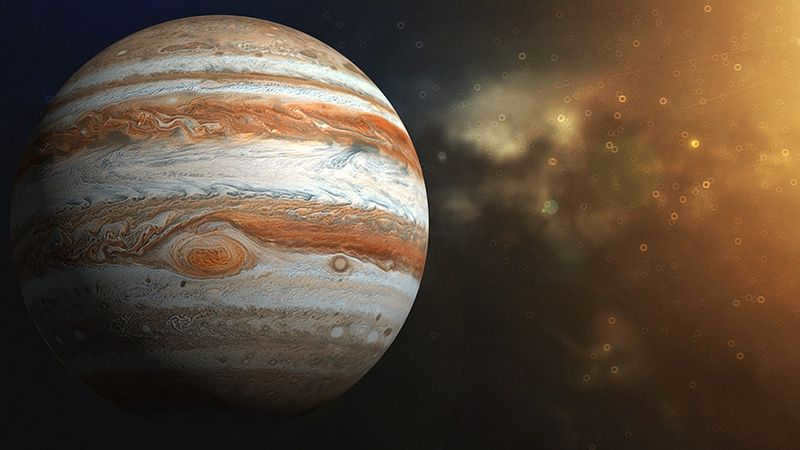
Overview
Jupiter, the fifth planet from the Sun, was supposedly discovered by Galileo Galilei, although it is possible that its existence was known much earlier. This celestial body was named after an ancient Roman deity.
Jupiter shares its celestial neighborhood with Mars and Saturn. It is approximately 2.5 times larger than all the other planets combined. There are currently 76 known natural satellites orbiting Jupiter. Although Jupiter possesses faint rings, they can only be observed from Earth under favorable weather conditions.
Composition and Structure
The composition and internal structure of Jupiter are not well understood. It is believed that the majority of its volume is comprised of liquid and gaseous substances. Within the planet, there is a dense core, which some scientists speculate may have a solid rocky composition. Surrounding the core is a thick layer of metallic hydrogen.
Next is a relatively thin layer composed primarily of liquid hydrogen. Its surface is sparsely populated. The uppermost layer consists of gaseous hydrogen. Jupiter’s atmosphere is composed of dense clouds. The planet is made up of 90% hydrogen and 8% helium, with the remaining 2% consisting of various other substances in small quantities:
- methane;
- sulfur;
- ethane;
- neon;
- carbon;
- hydrogen sulfide;
- water vapor;
- phosphine;
- oxygen;
- silicon;
- benzene;
- etc.
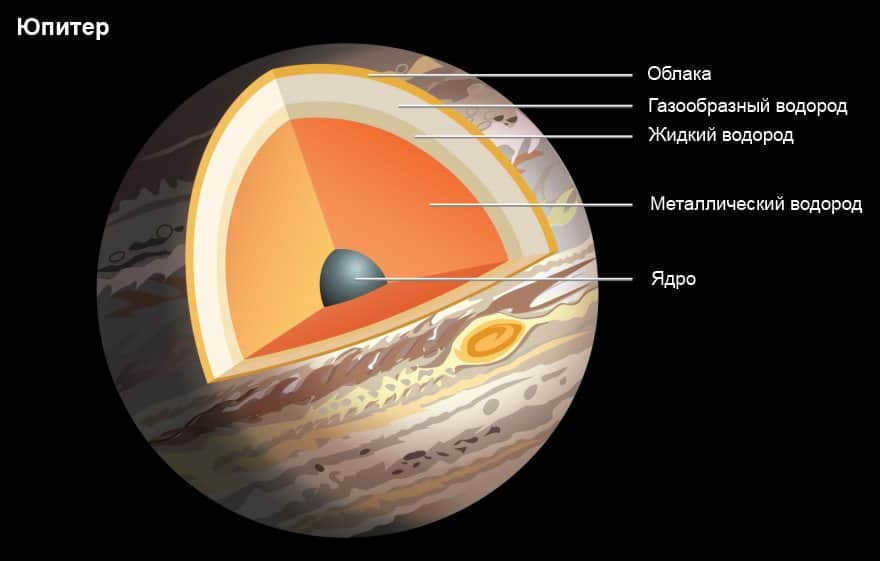
Orbital characteristics
Jupiter’s average distance from the Sun is about 778.57 million kilometers. Its farthest point from the Sun, called aphelion, is approximately 816.51 million kilometers away. On the other hand, its closest point to the Sun, known as perihelion, is about 740.68 million kilometers away. Jupiter completes one revolution around the Sun in about 11.86 Earth years, which is equivalent to 398.88 Jupiterian days. The planet orbits at a speed of approximately 13.07 kilometers per second.
Physical characteristics
Jupiter possesses a compressed shape. Its equatorial radius measures 71,492 km, while its polar radius measures 66,854 km. The mean radius is approximately 69,911 km.
This colossal gas giant has a mass of 1.89*10 to the power of 27 kg and a volume of 1.43*10 to the power of 15 km³. Despite its immense weight, the planet’s density is relatively low, measuring only 1.33 g/cm³. The planet’s surface area spans an impressive 6.22*10 to the power of 10 km². Jupiter’s axial tilt is 3.13°.
Characteristics of Jupiter’s Atmosphere and Radiation
Jupiter’s atmosphere is comprised of various layers, including the thermosphere, exosphere, tropopause, stratosphere, and troposphere. It is a volatile and ever-changing environment. While the planet does experience polar lights, they are not as pronounced as those on Earth. The atmospheric pressure on Jupiter ranges from 20 to 220 kPa, and the temperature is a chilling -145°C.
The weather conditions on Jupiter’s surface are highly unusual, with incredibly strong and turbulent winds blowing in multiple directions. These winds can reach speeds of up to 620 km/h, and storms can rapidly escalate to critical levels within a matter of hours.
Storms on Jupiter can span thousands of kilometers in diameter. It is believed that these storms lift substantial amounts of dust into the atmosphere. The planet’s surface is almost always covered by thick clouds composed of ammonium hydrosulfate, water vapor, and ammonia.
Periodically, there are recorded lightning flashes on the planet’s surface that are more intense than those on Earth. The planet also features anomalous zones, one of which is known as the Great Red Spot, a massive storm.

Jupiter is surrounded by intense radiation belts that pose a significant threat to human exploration. The high levels of radiation emitted by the planet make it extremely dangerous for vehicles to approach, often resulting in their failure.
Map of the Surface
Due to the dense cloud cover on the planet, studying the surface of Jupiter presents significant challenges. From Earth, our view of Jupiter is limited to its clouds. Fortunately, data collected from satellites has provided valuable insights, revealing that the planet’s surface exists in a molten state. As a result, traditional relief mapping is not possible for Jupiter. Instead, we rely on images and descriptions of storm zones to gain a better understanding of its surface.
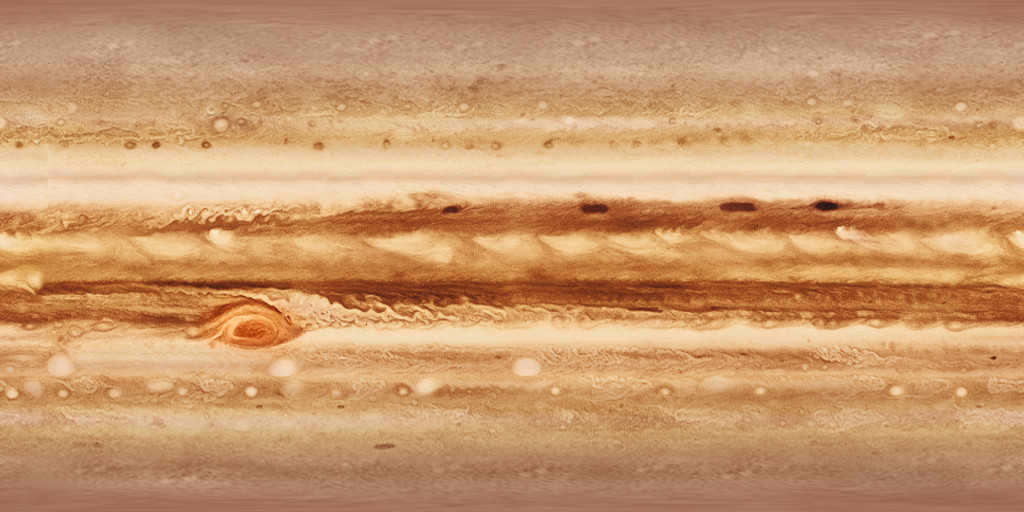
Due to the absence of a solid surface, creating a comprehensive map of Jupiter’s surface is impossible. However, scientists have managed to create a map of its storms. (Credit: astro.uni-altai.ru)
Newest findings from recent research
The study of Jupiter presents challenges due to increased radioactivity and a strong gravitational field. Only two spacecraft, Juno and Galileo, have been sent to explore this planet. Additionally, seven satellites have flown along specific trajectories to capture images. There are plans to send another spacecraft to Jupiter in the future.
The collected data has allowed scientists to determine the precise size of the planet’s major storm centers. The chemical composition and internal structures of Jupiter have also been revealed through these findings. Furthermore, valuable information about the planet’s natural satellites has been obtained.
Interesting facts about the colossal planet
In the last 35 years, astronomers have been closely studying the colossal planet, uncovering several intriguing aspects. Jupiter’s mass is a whopping 318 times that of Earth. Additionally, some of its moons are significantly larger than Earth’s diameter.
The aurora borealis on Jupiter is partly formed by volcanic emissions from its moon Io. Some scientists speculate about the possibility of life existing in the upper atmosphere, which contains a significant amount of ammonia. However, this hypothesis remains unconfirmed.
The Great Red Spot is the solar system’s longest-lasting hurricane, with a diameter reaching 30,000 kilometers. It has remained active for an astonishing 350 years.
There are certain areas on the surface of Jupiter where the temperature actually rises instead of decreasing when the shadows of its satellites fall upon them. Additionally, there are some satellites that orbit in the opposite direction of the planet.
Jupiter is the largest planet in our solar system and one of the most prominent in the night sky throughout the year. It derives its name from the Roman god of gods, Jupiter, who is equivalent to the Greek god Zeus.
When observing its orbit in relation to the Sun, Jupiter is the fifth planet in our solar system and boasts a minimum of 79 natural satellites. It has a diameter that is 11 times that of Earth and ranks as the second largest and heaviest object in our solar system, following only the Sun.
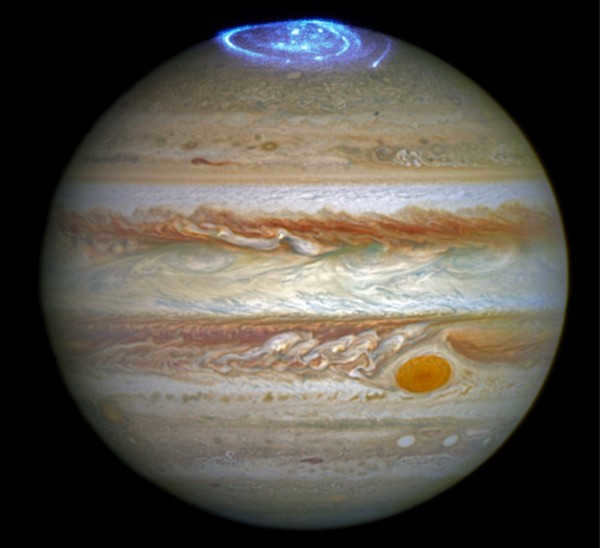
Figure 1: The image of Jupiter captured by the Hubble Space Telescope showcases its distinctive streaks, the prominent red spot, and the radiant glow of the planet. (source: NASA, ESA).
Jupiter has been a subject of human observation since ancient times. However, it was Galileo Galilei who first observed Jupiter through a telescope and made a groundbreaking discovery of its four main moons in 1610.
Galileo’s telescope observations unveiled the characteristic bands of Jupiter and the four Galilean moons, namely Io, Europa, Ganymede, and Callisto. These groundbreaking discoveries revolutionized our understanding of Earth’s place and the existence of other celestial bodies orbiting distant stars.
Galileo’s observations proved a few groundbreaking concepts during his time: firstly, that the Earth was not the focal point of the universe, and secondly, that there were “other worlds” beyond it, which he referred to as the satellites of Jupiter.
Overview of Jupiter’s key features
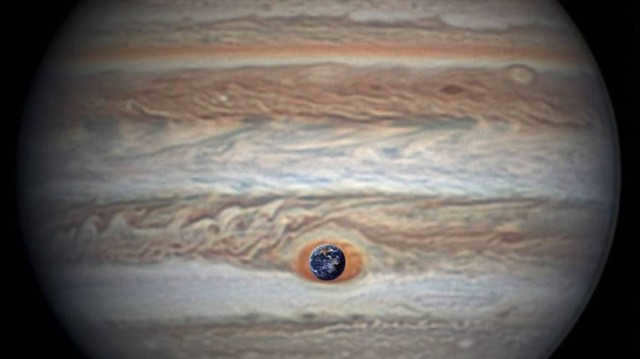
Figure 2. When comparing Earth to Jupiter, the Earth is loosely situated within the Great Red Spot. (Source: NASA / JPL-CALTECH)
Dimensions and Weight
Jupiter is classified as the fifth planet when considering its orbital radius in relation to the Sun. Mars is the fourth planet, but there is a distinct separation between them known as the asteroid belt.
Planets with an orbit smaller than that of the asteroid belt are composed of rock, while those with a larger orbit are considered gas or ice giants. Jupiter falls into the latter category and is also the largest in terms of volume and mass.
Jupiter’s mass, which is equivalent to 300 times the mass of Earth, is so substantial that it exceeds the combined mass of all the other planets in the solar system by two-fold. In terms of volume, Jupiter is equivalent to 1,300 Earths.
motions
Jupiter’s rotational speed is so rapid that it completes a full revolution in just 9 hours and 50 minutes, which is 2.4 times faster than the Earth. None of the other planets in our solar system can match this impressive rate of rotation.
As for its orbital period, Jupiter takes a remarkable 12 years to complete a full revolution around the Sun.
Observation
Despite being positioned at a distance from the Sun that is five times greater than that of our planet, Jupiter’s significant size and distinctive clouds enable it to reflect sunlight perfectly, making it one of the most luminous celestial bodies in the night sky.
When observed through a telescope, only the uppermost clouds are visible, some of which remain in fixed positions while others move, creating a series of bands along the equator.
The darker bands are referred to as belts, while the lighter regions are known as zones. These features are relatively stable, although their shape and color gradually change as they rotate in opposite directions around the planet.
The white clouds are formed by cooling upward air currents that result in the formation of ammonium crystals. These currents then curve sideways before descending back into the darker belts.
The array of hues, ranging from shades of red, yellow, and brown, that can be observed on Jupiter are a product of the various molecules that exist within the planet’s cloudy atmosphere. Amidst the bands and belts, massive storms and swirling formations emerge, appearing as dots or spots.
These tempests are nearly constant in nature, with one standout being the Great Red Spot, which was initially identified in the 17th century by Robert Hooke, a renowned physicist and rival of Isaac Newton.
The Great Red Spot has been in existence for at least 300 years, yet recent observations indicate that its immense size, surpassing that of Earth, has been gradually diminishing in size over the past few decades.
As for Jupiter’s atmosphere, it is notably dense, although its exact depth remains uncertain, estimates suggest it spans hundreds of kilometers.
Unique Essay
The composition of the atmosphere on Jupiter closely resembles that of the stellar atmosphere, consisting of 80% hydrogen, 17% helium, and small amounts of water vapor, methane, and ammonia.
As one delves deeper into Jupiter’s atmosphere, the atmospheric pressure steadily increases until hydrogen gas condenses into a vast ocean of liquid hydrogen. At such extreme pressure, this liquid hydrogen takes on the properties of a metal, thus marking the lower boundary of Jupiter’s atmosphere.
Jupiter’s ocean of metallic liquid hydrogen boasts temperatures surpassing the surface of the Sun, reaching around 10,000°C and emitting a dazzling brightness.
While it is highly probable that Jupiter harbors a dense core composed of heavy metallic elements, further data is required to substantiate this assertion.
An overview of the physical attributes of Jupiter
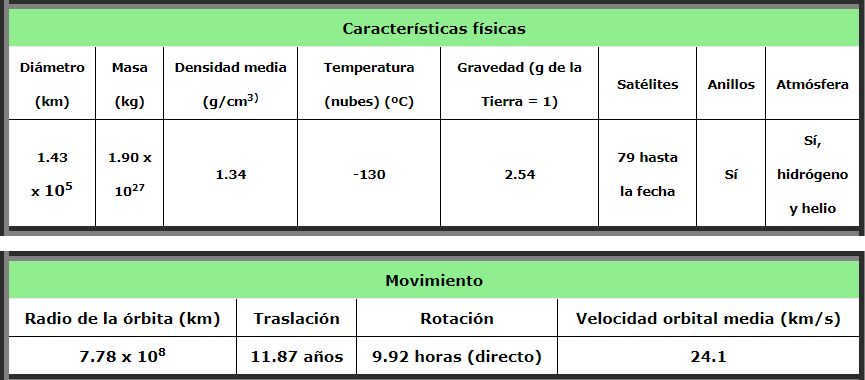
-Mass: 1.9 × 10 27 kg
-Equatorial radius : 71,492 km, which is 11 times the radius of Earth.
– Polar radius: 66854 kilometers.
-Shape: -flat at the poles by a factor of 0.065.
-Radius in orbit: 7.78 × 10 8 km, equivalent to 5.2 a.u.
– Tilt of the axis of rotation : 3º12 with respect to the orbital plane.
-Temperature: -130ºC (clouds)
-Gravity: 24.8 m/s 2
-An intrinsic magnetic field: Yes, 428 µTL at the equator.
-Atmosphere: A dense atmosphere of hydrogen and helium.
-Density: 1336 kg/m 3
-Satellites: There are currently 79 known satellites orbiting Jupiter.
-Rings: Yes, Jupiter has rings that are dim and composed of dust.
The composition of Jupiter
Jupiter’s outer layer consists of clouds and has a thickness of 50 kilometers. Below this cloud layer is another layer, which is primarily made up of hydrogen and helium and is 20,000 km thick.
The transition from the gas phase to the liquid phase is gradual as the pressure increases with depth.
Beneath this liquid layer, the extreme pressure causes the electrons of hydrogen and helium atoms to separate from their nuclei and become free electrons that move within a sea of liquid metallic hydrogen.
In deeper regions, there might exist a compact core that is 1.5 times larger in diameter compared to the Earth, but it is 30 times more massive. Because Jupiter is primarily composed of gas and liquid, the planet becomes flattened at its poles due to its incredibly rapid rotation.
When and how to view Jupiter
Jupiter appears as a vibrant white object and is easily visible during twilight. It should not be mistaken for Venus, which also shines brightly.

At first sight, Jupiter appears to be more luminous in the nocturnal firmament than Sirius, the most brilliant celestial body, and is consistently close to a distinct zodiacal constellation, which may differ annually under a temperature condition of 30 degrees Celsius.
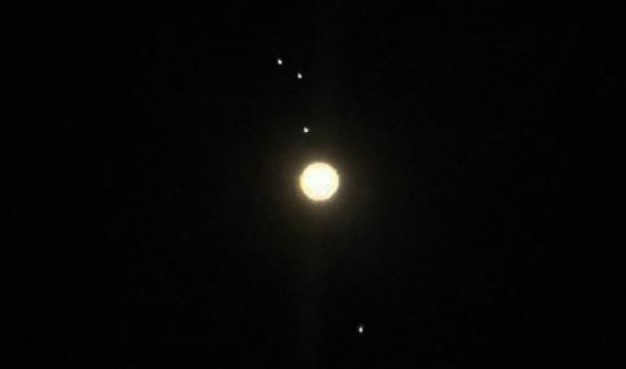
Figure 3. Night view of Jupiter and its four moons in a compact telescope. Source: @Asismet_IF.
In high-quality fixed binoculars or a compact telescope, Jupiter appears as a bright sphere with smooth bands.
The four moons of Jupiter can be easily observed in a compact telescope: Ganymede, Io, Europa, and Callisto. The position of the moons changes from day to day, and sometimes only three are visible due to some of them being behind or in front of the planet.
There are numerous mobile applications that can help you identify and locate planets and stars in the sky. One of the earliest and most popular is Sky Maps. It can provide you with the real-time position of Jupiter at any given moment.
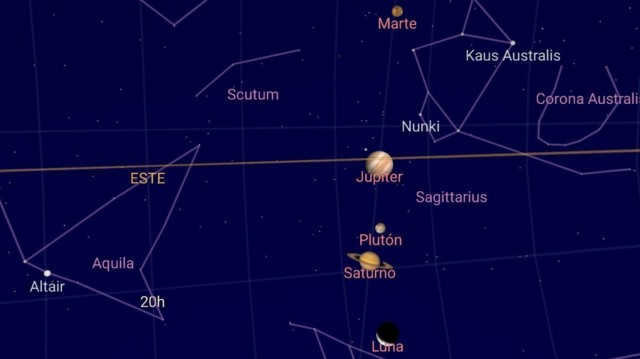
Figure 4 illustrates the placement of Jupiter and other planets in the celestial sphere. The data was acquired using Sky Maps on 20.02.20 at 23:14 from Caracas, Venezuela.
Orbital Movements
Jupiter’s path around the Sun is characterized by an elliptical shape, with its focus slightly offset from the center of the Sun due to its immense mass. It takes approximately 11.86 years for Jupiter to complete one orbit, traveling at an average speed of 13.07 km/s.
While it is generally accepted that the planets orbit around the center of the Sun, this is not entirely accurate for Jupiter.

Translation of Jupiter. Source: Todd K. Timberlake, author of Easy Java Simulation = Francisco Esquembre / CC BY-SA (https://creativecommons.org/licenses/by-sa/3.0)
The reason for this is that Jupiter’s immense size causes the center of rotation, center of mass, or center of mass of the Sun-Jupiter system to shift towards Jupiter when it is outside the solar body.
Based on calculations, the center of gravity of the Sun-Jupiter system is located 1.07 times the solar radius, which is outside of the Sun.

Figure 5: The Sun-Jupiter system has its center of gravity located outside of the Sun, causing Jupiter’s orbit to take the shape of an ellipse with one focus at the center of gravity. (Source: spaceplace.nasa.gov)
Perihelion refers to the point in Jupiter’s orbit that is closest to the focus of the ellipse, which is positioned at the center of gravity of the Sun-Jupiter system. The distance between perihelion and the focus is 816.62 million kilometers.
In contrast, aphelion represents the farthest distance between the focus and the orbit, which for Jupiter measures 740.52 million kilometers.
The eccentricity of an orbit indicates how much it deviates from a perfect circle. Jupiter’s orbit has an eccentricity of 0.048775 and is determined by dividing the distance from the center of the ellipse to the focus by the length of the ellipse’s major semi-axis.
Rotary motion
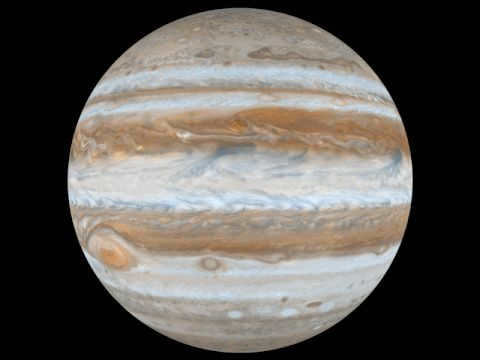
Jupiter completes one full rotation on its axis in a sideric period of 9 hours 55 minutes 27.3 seconds. The axis of rotation is inclined at an angle of 3.13º in relation to the orbital rotation axis.
Due to its massive size, Jupiter boasts the quickest rotation period among all the planets in our solar system.
Jupiter’s Moons
Giant planets, like Jupiter, are known for having a large number of moons or satellites. Currently, 79 moons have been identified orbiting Jupiter, but the most famous ones are the four moons that were discovered by Galileo Galilei in 1610. These moons, in order of their proximity to Jupiter, are:
– Callisto, which is slightly smaller than Earth
Together, these four moons account for 99.99% of the total mass of all the moons and rings around Jupiter.
In addition to these four main moons, there are four smaller inner moons that were discovered relatively recently in 1979.
On the outer side of the main moons, there is a group of ten regular satellites, as well as a group of retrograde satellites. So far, a total of sixty-one retrograde satellites have been identified.
The moons around Jupiter can be categorized into four groups based on their orbital radius:
- The Galilean satellites, which include Io, Europa, Ganymede, and Callisto, have orbits ranging from 422,000 km to 1,883,000 km. Collectively, they make up 99.99% of the mass of all of Jupiter’s satellites.
- The normal satellites have orbits ranging from 7,284,000 km to 18,928,000 km.
- The retrograde satellites have orbits ranging from 17,582,000 km to 28,575,000 km.
Jupiter is also accompanied by rings, which are located in a lower orbit compared to the Galilean satellites and between the orbits of the inner satellites. It is believed that these rings formed as a result of a collision between one of the inner satellites and a meteoroid.
Moons of Galileo
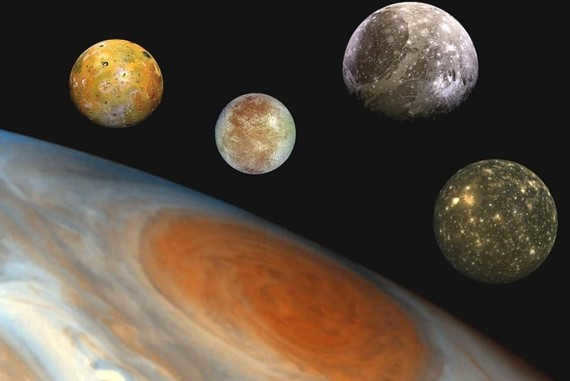
Figure 6: Jupiter and its four Galilean moons – Io, Europa, Ganymede, and Callisto. (Image source: wikimedia commons).
The four Galilean moons form a fascinating cluster, as they are thought to satisfy the prerequisites for potential colonization in the years to come.
Io
Io experiences intense volcanic activity, with its surface constantly being renewed by molten lava that originates from its interior.
The main source of heating energy for Io is the powerful tidal force generated by Jupiter’s immense gravity.
Europa
Europa is the second closest satellite to Jupiter among Galileo’s discoveries, and the sixth satellite overall. Its name is derived from Greek mythology, where Europa is Zeus’ (Jupiter in Roman mythology) mistress.
Europa, which is slightly smaller than the Moon, has a solid crust made up of frozen water. It also possesses a relatively thin atmosphere composed of oxygen and other gases. The surface of Europa is known for its smooth, striped appearance, making it one of the smoothest celestial bodies in the solar system with very few craters.
There is a belief that beneath Europa’s icy shell lies an ocean, which experiences tectonic activity on the satellite’s icy surface due to the gravitational forces of the massive planet Jupiter. As a result, cracks and grooves form on the otherwise smooth surface.
A significant number of specialists hold the belief that Europa possesses the necessary conditions to support some form of life.
Ganymede
Ganymede, the largest satellite of the solar system, possesses a rocky and icy mantle with an iron core. It boasts a size that is slightly larger than that of the planet Mercury, while maintaining almost half its mass.
Recent findings suggest that Ganymede may harbor an ocean of salt water beneath its surface. The European Space Agency (ESA) has expressed interest in conducting a mission to explore this intriguing moon in 2030.
In a pattern commonly observed in the Solar System, Ganymede’s orbit is in resonance with the orbits of Europa and Io. Specifically, for every one revolution made by Ganymede, Europa completes two revolutions, while Io completes four.
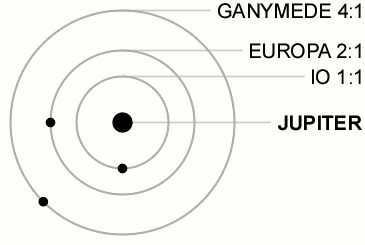
Figure 7. The orbital resonance of Jupiter’s Galilean satellites is depicted in this image taken from wikimedia commons.
Callisto
Callisto, the fourth Galilean satellite, has a similar size to Mercury but is only one-third of its weight. Unlike the other satellites, Callisto does not have any orbital resonance, but it is in synchronized rotation with Jupiter, always keeping one face towards the planet.
The surface of Callisto is covered with ancient craters and is primarily composed of rock and ice. It is believed to have an internal ocean that is at least 100 kilometers thick.
There is no evidence of tectonic activity on Callisto, so its craters are likely the result of meteorite impacts. The atmosphere of Callisto is thin and consists of molecular oxygen and carbon dioxide, with a relatively strong ionosphere.
Unique Essay
Jupiter possesses a dense atmosphere that primarily consists of hydrogen, making up approximately 87% of its composition, while helium accounts for around 13%. Other gases, such as hydrogen sulfide, water vapor, and ammonia, are present in trace amounts, less than 0.1%.
The clouds on the planet contain ammonia crystals, which contribute to their reddish hue, possibly due to the presence of sulfur or phosphorus molecules. The lower, unseen clouds contain ammonium hydrosulfide.
Given the existence of thunderstorms in the deeper layers, it is highly probable that these layers contain clouds composed of water vapor.
Structure within Jupiter
Jupiter’s interior is composed of hydrogen and helium, which exist in liquid form due to the immense pressure caused by its strong gravity and dense atmosphere.
Approximately 15,000 kilometers beneath the liquid surface, the hydrogen atoms are under such extreme compression that the electrons separate from the atoms and form a conductive band, resulting in the formation of liquid metallic hydrogen.
According to physical models, there is believed to be a rocky core located even deeper within Jupiter. This core is composed of heavy atoms. Initially, scientists estimated the core to be equivalent to 7 times the mass of Earth, but more recent models suggest a core mass ranging from 14 to 18 times that of Earth.
Confirming the existence of such a core is crucial, as it would validate the theory of planetesimal formation in the creation of planets.
According to this concept, planets are formed through the aggregation of solid particles, resulting in the formation of larger, denser objects that serve as gravitational condensation centers, eventually leading to the creation of planets over millions of years.
The Magnetic Field of Jupiter
Due to the incredibly strong magnetic field of Jupiter, the planet possesses a vast magnetosphere that is so extensive that, if it were visible, it would appear in the Earth’s sky as a moon-sized object.
Jupiter surpasses all other planets in the solar system in terms of both the intensity and size of its magnetic field.
Charged particles within the solar wind are captured by the magnetic field lines and revolve around them, while also exhibiting drift or movement along the lines of force.
When the magnetic field lines emerge from one pole and connect to the other, the charged particles acquire kinetic energy and concentrate at the poles, causing ionization and excitement of the gases in Jupiter’s polar atmosphere, which subsequently leads to the emission of light radiation.
Exploration of Jupiter
Since 1973, NASA, the United States’ space agency responsible for space exploration programs, has sent several missions to Jupiter.
Missions like Pioneer 10 and 11, Galileo, and Cassini have conducted studies on Jupiter’s moons. Initial findings suggest that some of these moons have conditions favorable for life, as well as potential human bases.
The North American space agency NASA and the European space agency ESA are currently planning new missions to Jupiter, with a primary focus on studying the moon Europa in more detail.
pioneer
The pioneer spacecraft Pioneer 10 made history when it became the first probe to successfully pass over Jupiter in December of 1973. Just a few months later, in April of the same year, the Pioneer 11 probe was launched and eventually reached Jupiter’s orbit in December 1974.
These groundbreaking missions provided humanity with the first ever close-up images of Jupiter and its Galilean satellites. Additionally, scientists were able to measure the planet’s magnetic field and radiation belts during these expeditions.
In addition to being launched in 1973, the Voyager 1 and Voyager 2 missions once again explored the ruler of the solar system, Jupiter.
The information gathered during these missions revealed unique and previously unknown details about the planet and its moons. One significant discovery was the existence of Jupiter’s ring system, which had never been observed before. Additionally, the moon Io gained recognition for its highly active volcanoes.
Galileo
In 1995, Galileo was sent on a mission to explore Jupiter for a duration of seven years. However, the probe encountered significant issues with its primary antenna. Despite these challenges, it managed to transmit valuable data about the satellites orbiting Jupiter.
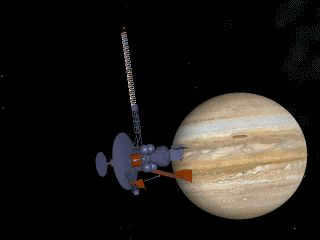
Illustration 9. The Galileo spacecraft circling around the planet Jupiter. Source: Wikimedia Commons. jihemD / CC BY-SA (http://creativecommons.org/licenses/by-sa/3.0/),
The mission unveiled hidden oceans beneath the surface of Europa and gathered additional data on the active volcanoes of Io.
The “Galileo” expedition came to a close when the research probe intentionally crashed into Jupiter in order to prevent any potential contamination of Europa’s frozen terrain.
Cassini
In December 2000, the Cassini/Huygens mission to Saturn collected data that was just as intriguing as the information gathered during the Voyager missions. However, thanks to advancements in technology, the quality of the data was significantly superior.
New Horizons
During its journey to Pluto, the New Horizons space probe made a stop at the planet Jupiter in 2007.
The Juno space probe, which arrived at Jupiter on July 5, 2016, is the latest mission to the planet. Its primary objective is to examine Jupiter’s atmosphere, magnetosphere, and auroras.
By collecting data, this mission aims to establish which core models align with the current knowledge of Jupiter. Additionally, it will compare these models with those that propose the absence of a core.
Fascinating information about Jupiter
-Jupiter, along with Saturn, Uranus, and Neptune, is one of the four massive planets in our solar system, and it holds the title for being the largest in terms of diameter.
-If we were to compare the volume of Jupiter to Earth, it would take approximately 1,300 Earth-sized planets to fill the space occupied by Jupiter.
-The mass of Jupiter is truly astonishing, as it is two and a half times greater than the combined mass of the other seven planets in our solar system.
-Scientists believe that Jupiter’s solid core formed a mere million years after the initial formation of the gas and dust disk that eventually led to the creation of our solar system, which occurred approximately 4.5 billion years ago.
-Jupiter holds the record for having the shortest day among all the planets in our solar system, with a rotation period of only 9 hours and 55 minutes.
-Not only is Jupiter known for reflecting sunlight in its atmosphere, it is also the most radioactive planet in our solar system, emitting its own radiation primarily in the infrared range.
-Jupiter boasts the solar system’s most massive moon, Ganymede, which has a radius 1.5 times that of the Moon and 0.4 times the radius of Earth.
-Approximately 80% of Jupiter’s atmosphere is composed of hydrogen, with helium making up 17%. The remaining portion consists of other gases including water vapor, methane, ammonia, and ethane.
-Ammonium crystals form a thin layer about 50 kilometers thick in Jupiter’s clouds. However, the planet’s overall atmosphere spans about 20,000 km, making it the thickest among all the planets in the solar system.
-Jupiter is home to the solar system’s largest and longest-lasting anticyclonic vortex, known as the Great Red Spot. With a size exceeding two Earth diameters, this storm has persisted for over 300 years.
-Beneath its surface, Jupiter possesses an incredibly dense core comprised of iron, nickel, and liquid metallic hydrogen.
– With its powerful magnetic field, it has the ability to create permanent auroras.
– Among all the planets in our solar system, it boasts the highest gravitational acceleration, estimated to be 2.5 times stronger than Earth’s gravity at the edge of its atmosphere.
– Recent research findings suggest that there is a significant amount of water in the equatorial region of this planet. This conclusion was drawn from the analysis of data collected by the Juno space mission. According to a NASA report published in the journal Nature Astronomy on February 10, 2020, approximately 0.25% of the planet’s equatorial atmosphere consists of water molecules.
References
- Source: astrofisicayfisica.com
- Seeds, M. 2011. The solar system. 7th edition. Cengage Learning.
- Cosmos. The biggest planet in our solar system. Retrieved from: space.com
- Wikipedia. Jupiter’s moons. Retrieved from: es.wikipedia.org.
- Wikipedia. Jupiter (planet). Retrieved from: es.wikipedia.org.
- Wikipedia. Jupiter (planet). Retrieved from: en.wikipedia.org.

Jupiter, the largest planet in the solar system and the fifth one to be discovered, has been known since ancient times. It was named after the Roman god Jupiter, who was equivalent to the Greek god Zeus. Positioned beyond the asteroid belt, Jupiter is predominantly made up of gases, with hydrogen and helium being the most abundant. With a mass of 1.9×10^27 kg, Jupiter’s mass is nearly 2.5 times greater than the combined mass of all the other planets in the solar system. Jupiter completes a full rotation around its axis in 9 hours and 55 minutes, while its orbital velocity is 13 km/s. The sideric period, which refers to the time it takes for Jupiter to complete a full rotation around the sun, is approximately 11.87 years.
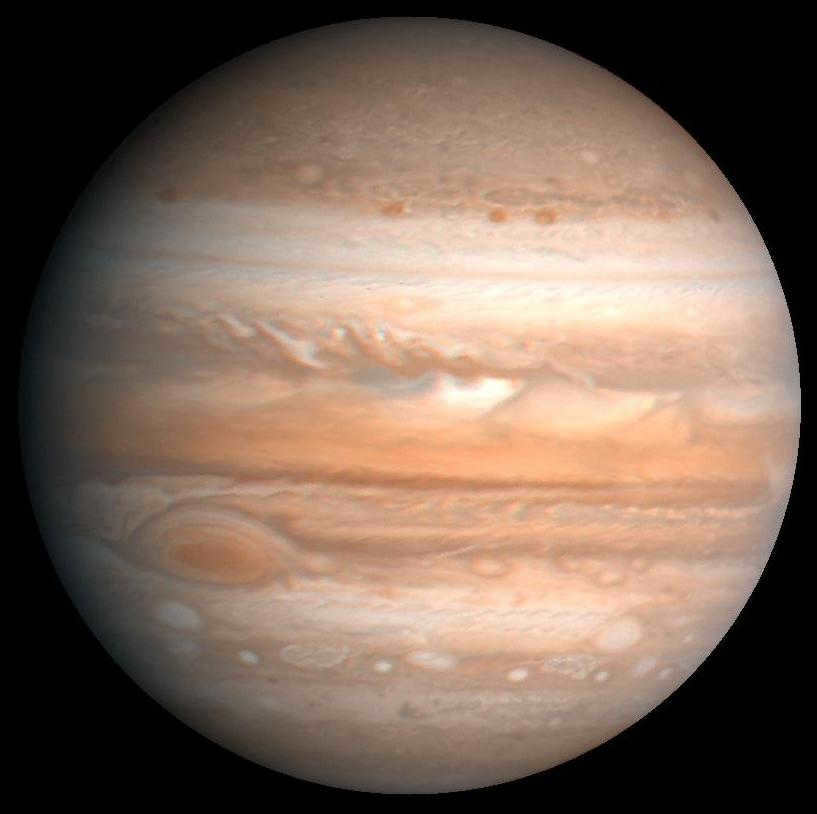
The Composition of Jupiter
According to contemporary scientific knowledge, the central core of Jupiter is estimated to have a mass equivalent to 10 times that of Earth. This core accounts for around 4% of the planet’s overall mass and has a diameter approximately 1.5 times that of Jupiter itself. The core consists primarily of rock, with some evidence of icy materials present as well.
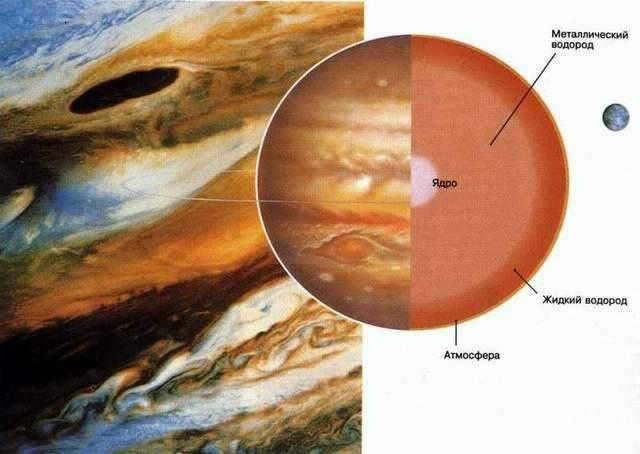
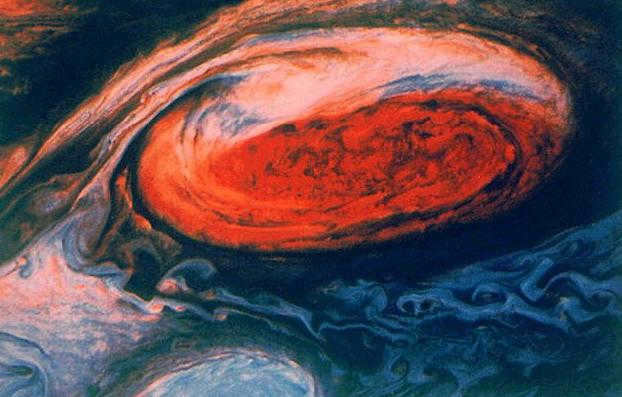
One of the most mysterious and lasting phenomena mentioned in the features of a planet is undoubtedly the well-known Great Red Spot on Jupiter. This remarkable feature was first detected by Robert Hooke in 1664, making it a subject of observation for almost 350 years. The Great Red Spot is an enormous formation that continuously alters its size. It is believed to be a massive, long-lasting atmospheric vortex, measuring approximately 15×30 thousand kilometers in dimensions. To put it into perspective, the diameter of the Earth is about 12.6 thousand kilometers.
The magnetic field of Jupiter
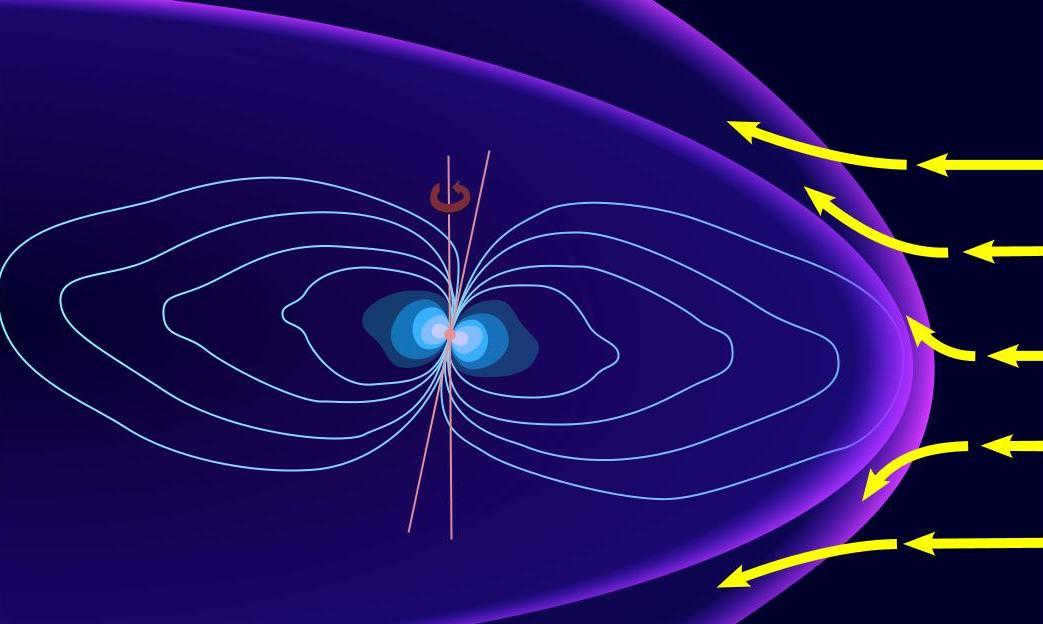
Jupiter’s magnetic field is incredibly vast, extending beyond even Saturn’s orbit for about 650,000,000 km. It surpasses Earth’s magnetic field by nearly 12 times, with its magnetic axis inclined at 11 degrees relative to its rotation axis. The presence of metallic hydrogen within the planet’s interior accounts for its immense magnetic field. Metallic hydrogen acts as an exceptional conductor and, when rotating at high speeds, generates magnetic fields. Similar to Earth, Jupiter also possesses two magnetic poles that are inverted. However, the compass on this gaseous giant always points southward.
Currently, there are approximately 70 known satellites of Jupiter, although it is believed that there may be around a hundred in total. The initial four satellites of Jupiter, namely Io, Europa, Ganymede, and Callisto, were first observed by Galileo Galilei in 1610.
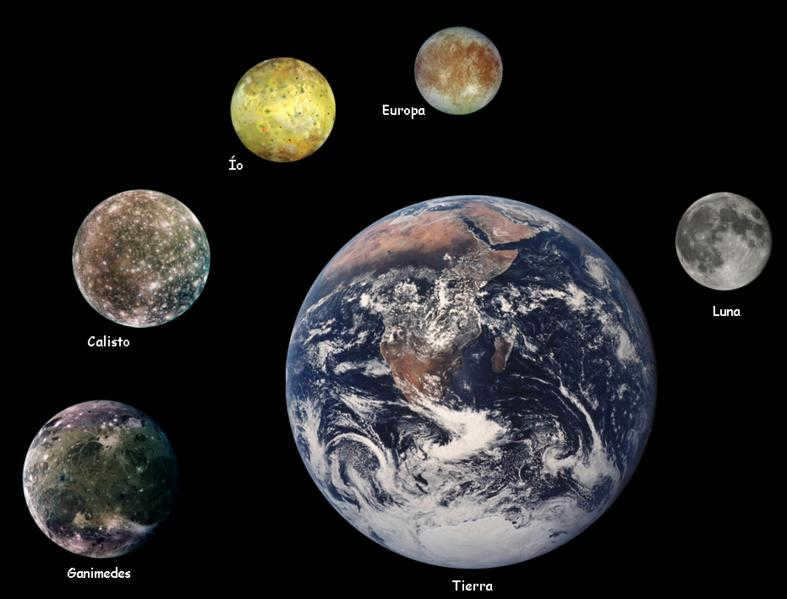
Distinctive Features of Jupiter
– Mass: 1.9*1027 kg (318 times greater than Earth’s mass)
– Equatorial Diameter: 142984 km (11.3 times larger than Earth’s diameter).
– Polar Diameter: 133708 km
– Axial Tilt: 3.1°
– Density: 1.33 g/cm3
– Upper Layer Temperature: approximately -160 °C
– Rotation Period (day): 9.93 hours
– Average Distance from the Sun: 5.203 astronomical units or 778 million kilometers
– Orbital Period (year): 11.86 years
– Orbital Velocity: 13.1 km/sec.
– Orbital Eccentricity: e = 0.049
– Orbital Inclination to the Ecliptic: i = 1°
– Gravitational Acceleration: 24.8 m/s2
– Satellites: there are 70
Navigation
Posts
One of the greatest challenges in the realm of manned missions to Mars is ensuring the successful and secure transportation of astronauts to the Red Planet’s surface.
In the present day, numerous scientists, philosophers, and everyday individuals are still preoccupied with the query of whether extraterrestrial life or even entire alien civilizations exist. Countless movies and books have been dedicated to exploring this enigma.
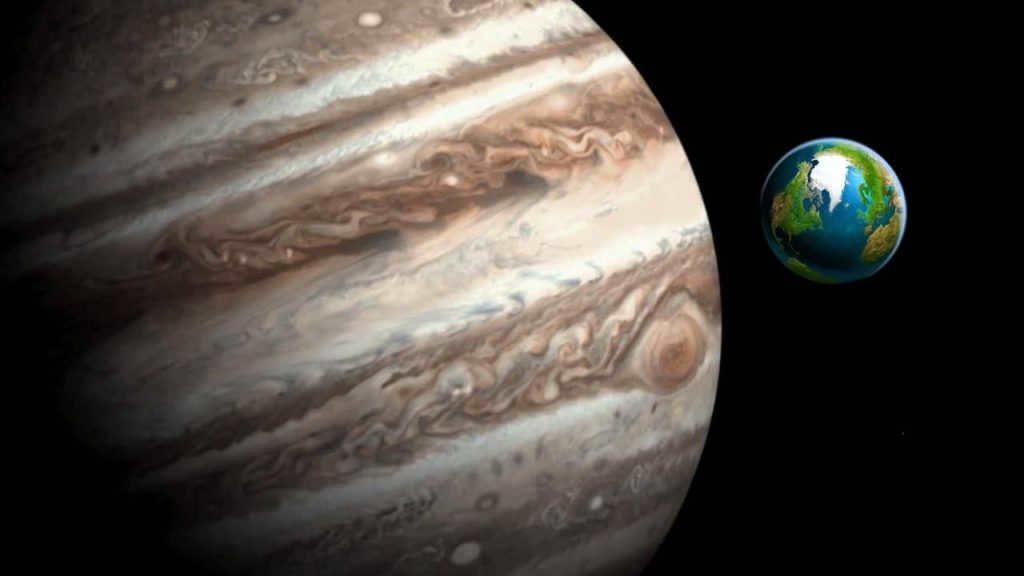
Jupiter, like every other planet in our solar system, boasts an array of extraordinary attributes. It stands out for its remarkable size, mass, magnetic field strength, lengthy daylight hours, abundance of satellites, and possession of the largest moon in the entire system. Fascinating tidbits about Jupiter unequivocally label it as one of the most unparalleled planets in existence.
Mass and Dimension
Jupiter, the biggest and most massive celestial body in our solar system, boasts a radius of 71,000 kilometers, which is a staggering 11 times larger than that of Earth. In terms of weight, Jupiter weighs in at a whopping 1.8986⋅10 27 kg, making it 318 times heavier than our home planet. In fact, Jupiter’s mass is 2.5 times greater than the combined mass of all the other planets in our solar system.
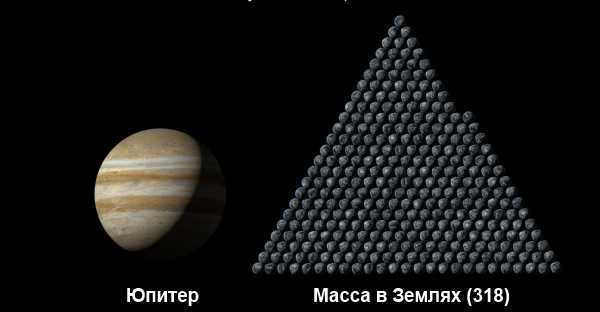
Simultaneously, it weighs 1000 times less than the Sun and could potentially be classified as a star (specifically, a brown dwarf) if its mass were 50 times larger.
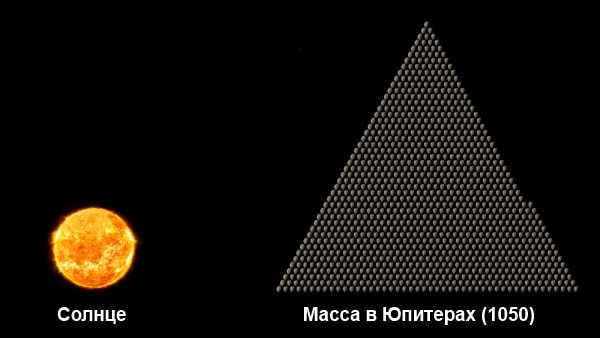
Intense luminosity
Jupiter stands out as the third most brilliant entity within our solar system, surpassed only by the radiant Venus and the Moon.
Swift rotational velocity
The axial rotation of Jupiter outpaces that of the other celestial bodies in our planetary system. The span of a single day (equatorial rotation period) amounts to 9 hours, 50 minutes, and 30 seconds.
Due to its rapid rotation, the planet exhibits some degree of oblateness – the equatorial radius exceeds the polar radius by 6.5%.
Jupiter’s revolution around the Sun is comparatively sluggish, with one complete orbit taking 12 Earth years.
Lack of a Solid Surface
The gaseous nature of the substances present on the planet prevents the existence of a solid surface. However, there is a conditional surface located in the upper atmosphere, where the pressure is equivalent to that of Earth.
Extreme Conditions on Hot Jupiter
At the highest cloud layers, the temperature drops to -145°C. As we descend to a depth of 145 km, the temperature rises to 153°C. Below the clouds, where hydrogen undergoes a phase transition from a gas to a liquid, the temperature gradually increases to a staggering 6000°C. In the core, the temperature reaches an astounding 36,000°C.
Magnetic Field
Jupiter possesses the most powerful magnetic field in our solar system, surpassing that of Earth by 20,000 times. The generation of this magnetic field is a result of dynamic phenomena, and Jupiter maintains its strength through the presence of a conductive layer composed of metallic helium.
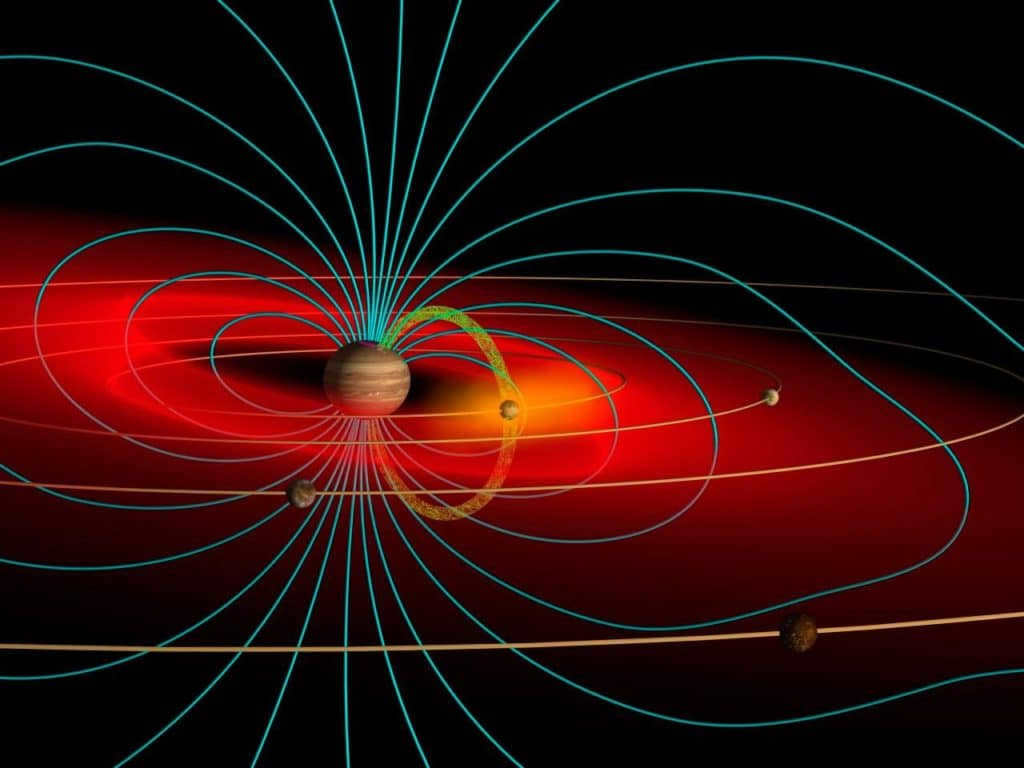
Radiation belts
Jupiter possesses formidable radiation belts, with radiation levels several times greater than the lethal dosage for human beings.
This poses a significant obstacle to the exploration of the planet by landing stations, whose electronic instruments are susceptible to malfunctioning in the presence of intense radiation.
The structure of Hot Jupiter consists of three layers: a rocky core, a layer of metallic hydrogen, and an atmosphere. Its gas shell is divided into three layers:
- Outer layer composed of hydrogen;
- Middle layer composed of hydrogen-helium, with a 9:1 ratio of hydrogen to helium;
- Inner layer composed of helium and hydrogen, as well as substances that form three cloud layers: upper ammonia, middle ammonium hydrosulfite, and lower ice and water vapor.
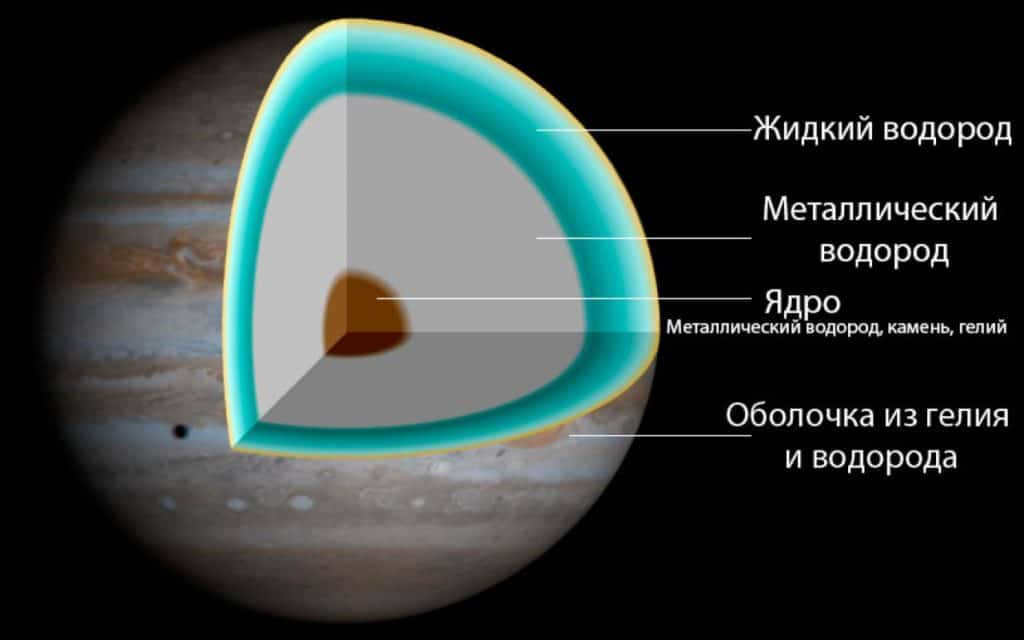
The Amazing Red Spot
Created by the vertical motion of air masses and first observed in 1664 by R. Hooke. This colossal hurricane, measuring 15×30 thousand kilometers, holds the title of the largest storm in the entire solar system. The coloration of the spot’s clouds is not consistent: the uppermost clouds appear blue, while brown and white clouds lie beneath them.
The lowest clouds, however, take on a mysterious red hue that continues to baffle scientists. It is believed that this red color is caused by the presence of phosphorus chemical compounds.
The Great Red Spot whirls at an astonishing speed of 350 kilometers per hour. The air masses on the periphery rotate in the opposite direction, while those at the center move in a clockwise fashion. This disparity is attributed to a temperature variation of 3-4°C between the central region and the outer edges.
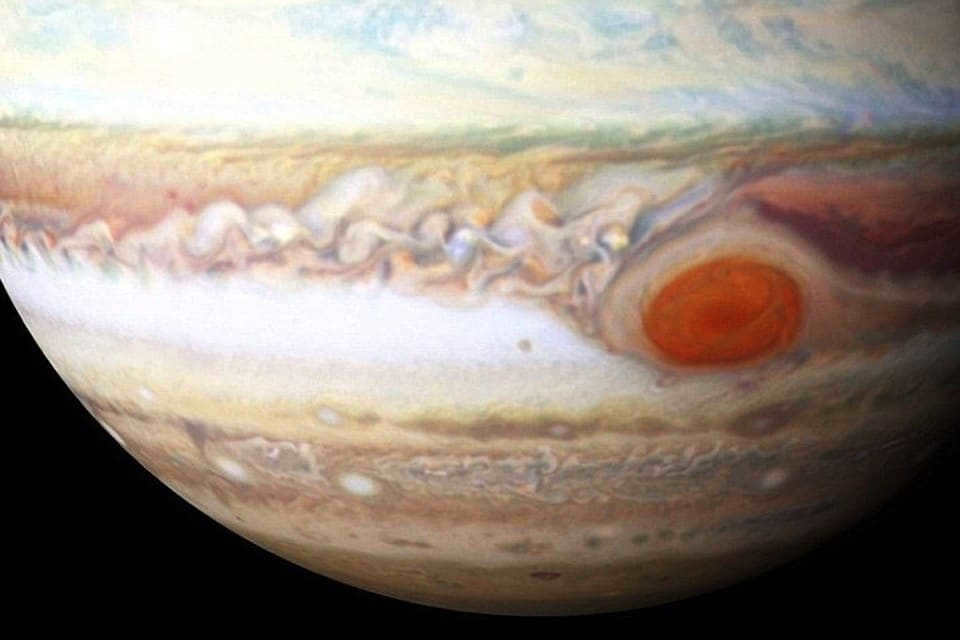
The Remarkable X-ray Spot
The Chandra telescope made a groundbreaking discovery in 2000 – the existence of an extraordinary X-ray spot. This mysterious spot is found in the polar regions, particularly in the northern areas, leaving scientists puzzled about its origin and nature.
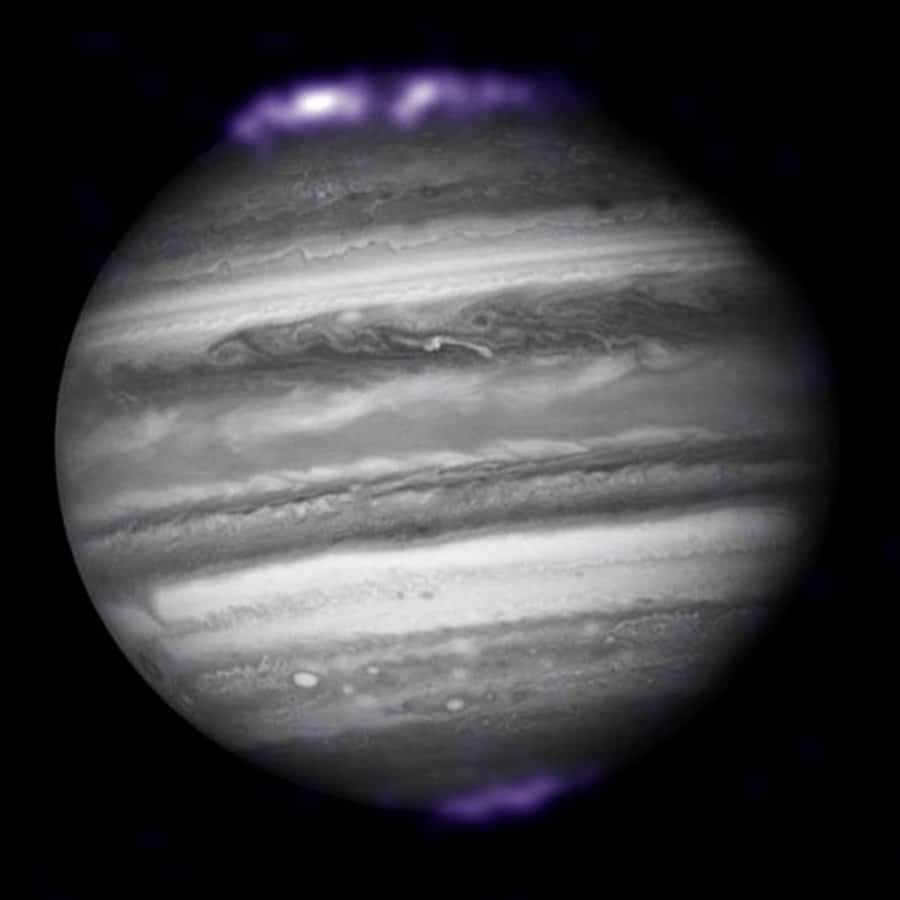
The Discovery of Jupiter’s Rings
In the late 1980s of the 20th century, astronomers made a remarkable discovery: Jupiter has rings. These rings are divided into three main sections. The outermost is a delicate outer spider web, followed by the main ring, which eventually transitions into the halo.
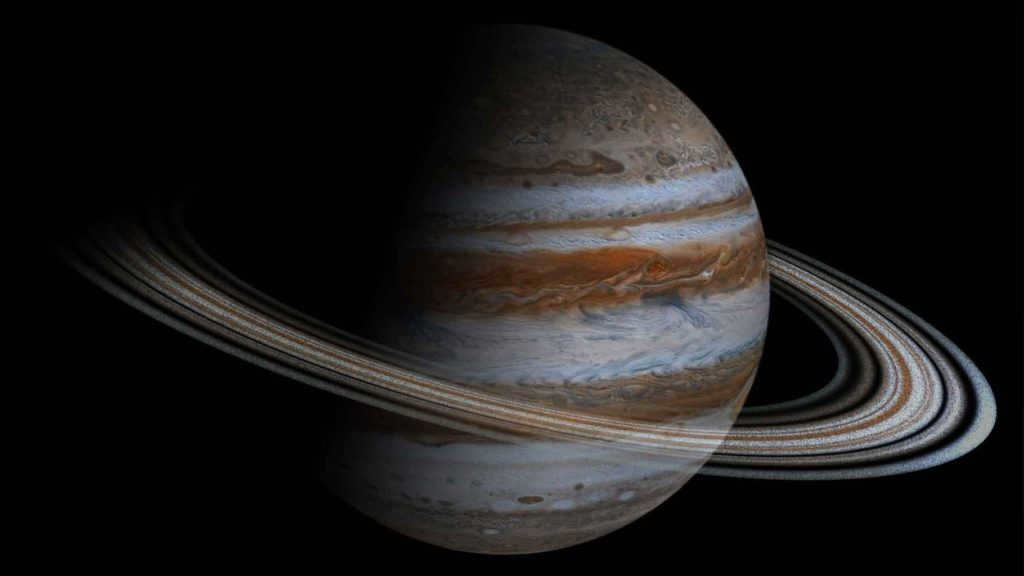
Satellites and “hot shadows”
Jupiter boasts the most extensive collection of satellites in the solar system, with a total of 79 orbiting around it. Among these, the four largest ones, Callisto, Io, Europa, and Ganymede, were first observed by Galileo during the early 17th century. Ganymede, in particular, stands out as the largest satellite not just of Jupiter but of all the planets in the solar system. Its size exceeds that of Mercury, the smallest planet in the Earth group, by a remarkable 8%.
While the majority of Jupiter’s satellites follow a forward rotation, there are a few exceptions like Karme and Pasiphae, which rotate in the opposite direction. It is believed that these satellites might have been captured by Jupiter from outer space, rather than forming alongside it like the others.
A fascinating phenomenon associated with these satellites is the presence of “hot shadows.” In these areas, the temperature appears to be significantly higher than the surrounding regions.
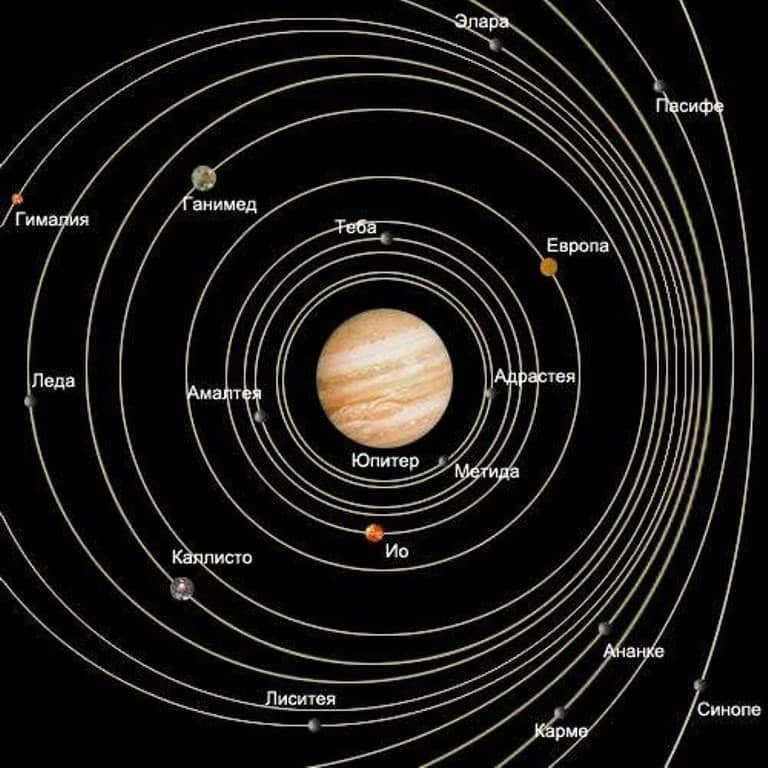
“Diamonds falling from the sky”
Scientists have proposed a fascinating theory that suggests diamonds may be raining down on Jupiter. It is believed that the lightning discharges in Jupiter’s atmosphere can convert methane into crystalline carbon.
These carbon particles then combine and form clumps, which, under extreme temperatures, transform into diamonds as they fall towards the planet’s surface.
Sounds of Jupiter
In 2016, while orbiting the planet, the Juno spacecraft recorded unique sounds that resembled the ringing of a distant bell, mixed with other noises. The origin of these sounds remains unclear to scientists.
Hypothesis of Life on Jupiter
In the 1970s, renowned American astronomer Carl Sagan and astrophysicist E.E. Salpeter put forward a hypothesis suggesting the possibility of water-hydrocarbon based life forms on Jupiter. They described two potential types of life:
- Floaters – gigantic organisms that inhabit the upper layers of Jupiter’s atmosphere and derive sustenance from either pre-cooked or self-synthesized organic matter.
- Sinkers – small organisms with exceptionally high reproductive rates. Some of them manage to survive in the hotter lower atmospheric layers, aided by convective currents.
- Predators that consume phloaters are known as hunters.
Recently, scientists from Brazil have proposed the presence of bacteria that can consume radiation on the planet.
Etymology
Who is the planet Jupiter named after? It is named after the mighty god of the sky and thunder in ancient Roman mythology. Jupiter was the chief deity in the ancient Roman pantheon and represented divine power. He governed the order of the world, the cycle of day and night, and the seasons.
The ancient Romans named the planet Jupiter in recognition of its immense size and slow rotation. As the celestial ruler, Jupiter traverses the sky and ensures the adherence to all earthly laws.
The extraordinary features and characteristics of the planet Jupiter make it one of the most enigmatic celestial bodies. And the planet shows no haste in unveiling its secrets.
Since 2018, there have been only two orbital missions – Galileo and Juno – carried out after 35 years of studying the planet.
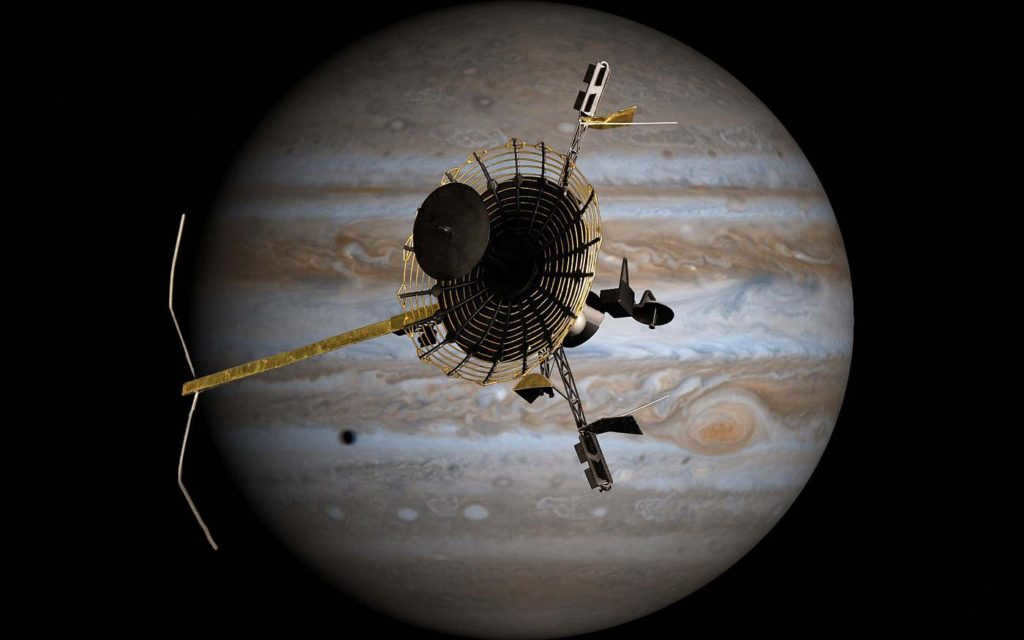
These challenges arise from the vast distance and the intense radiation that spacecraft must navigate to reach Jupiter. However, scientists remain determined to gather precise data about this celestial object.






